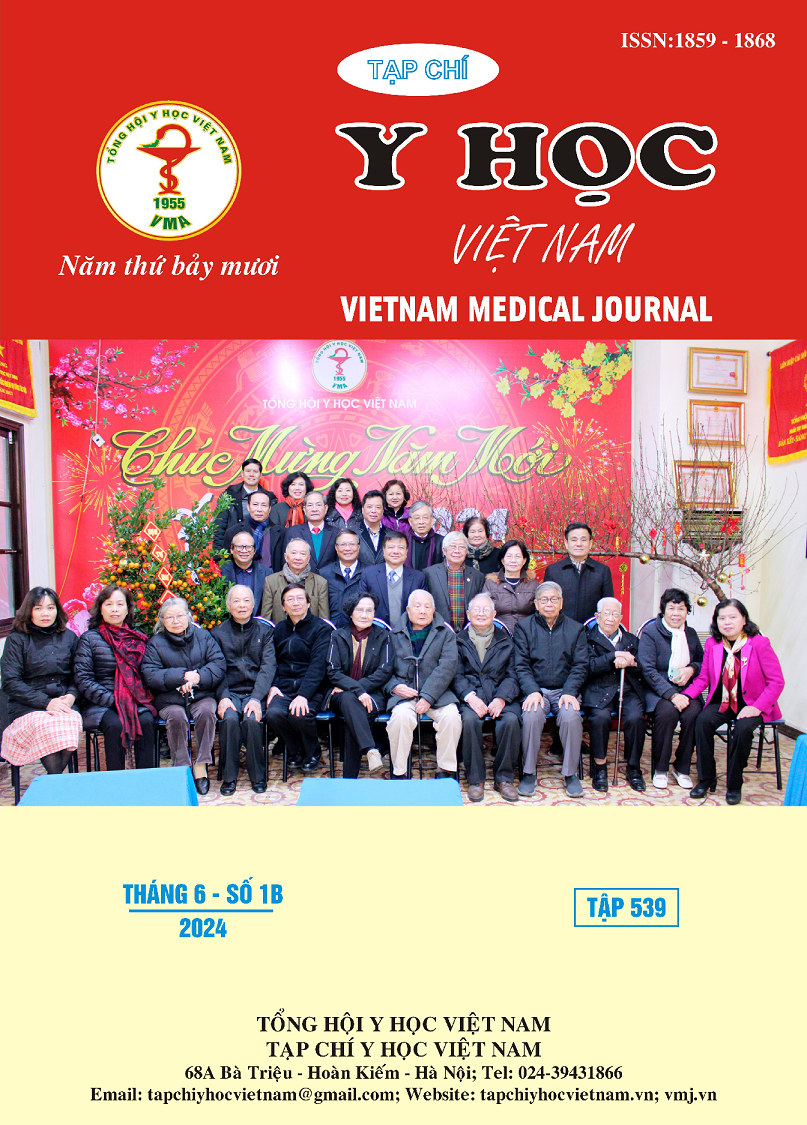PULMONARY ATRESIA WITH VENTRICULAR SEPTAL DEFECT: RESULTS OF TOTAL REPAIR SURGERY USING VALVED CONDUIT AT VIETNAM NATIONAL CHILDREN’S HOSPITAL
Main Article Content
Abstract
Objectives: Describe the results of total repair surgery for pulmonary atresia with ventricular septal defect (PA/VSD) using valved conduit at Vietnam National Children's Hospital.Methods: This was a series case study. The study included all patients underwent total repair surgery for PA/VSD using valved conduit at Vietnam National Children's Hospital from January 2016 to December 2022. Results: 140 patients enrolled during the study period. There was 79 male patients (56%). At the time of surgery, the median age was 11.1 months, the median weight was 6.75 kg. The conduit Contegra (88%) and Hancock (12%) were implanted. Postoperative complications prolonged the duration of postoperative mechanical ventilation ≥ 68 h, and the ICU stay ≥ 6 days (p < 0.01). The early mortality rate was 3.6%. The late mortality rate was 4.4%. The rate of re-operation and/or re-intervention was 21.6%. 127 patients completed the follow-up with a median of 3 years. The overall survival rate after a follow-up period of more than 5 years was 88.4%.Conclusions: The total repair surgery of PA/VSD using valved conduit at Vietnam National Children's Hospital resulted in good outcomes. Long-term study and monitoring of the progression of the pathology and assessment of the longevity of the artificial conduit are necessary
Article Details
Keywords
Pulmonary Atresia-Ventricular Septal Defect, Valved Conduit, Congenital heart defect
References
2. Bertranou EG, Blackstone EH, Hazelrig JB, Turner ME, Kirklin JW. Life expectancy without surgery in tetralogy of fallot. The American Journal of Cardiology. 1978;42(3):458-466. doi: 10.1016/0002-9149(78)90941-4
3. Tchervenkov CI, Roy N. Congenital Heart Surgery Nomenclature and Database Project: pulmonary atresia—ventricular septal defect. The Annals of Thoracic Surgery. 2000;69(3):97-105. doi:10.1016/S0003-4975(99)01285-0
4. Soquet J, Barron DJ, d’Udekem Y. A Review of the Management of Pulmonary Atresia, Ventricular Septal Defect, and Major Aortopulmonary Collateral Arteries. The Annals of Thoracic Surgery. 2019; 108(2): 601-612. doi:10.1016/ j.athoracsur.2019.01.046
5. Vinh TQ, Truong NLT, Hung DQ. Definitive repair of pulmonary atresia with ventricular septal defect using valved conduit for low body weight infant. TCNCYH. 2022;161(12E11):227-237. doi:10.52852/tcncyh.v161i12E11.1340
6. Ma J, Tan T, Zhang S, et al. Long-term outcomes of pulmonary atresia with ventricular septal defect by different initial rehabilitative surgical age. Front Cardiovasc Med. 2023; 10:1189954. doi:10.3389/fcvm.2023. 1189954
7. Elhedai H, Mohamed M, Mohammed SSS, Mustafa KHH, Seedahmed MHA, Mohamedahmed AYY. Comparison of staged repair versus single-stage complete repair for pulmonary atresia with ventricular septal defect: A systematic review and meta-analysis. Indian J Thorac Cardiovasc Surg. 2022;38(1):5-16. doi: 10.1007/s12055-021-01296-w
8. Morales DLS, Braud BE, Gunter KS, et al. Encouraging results for the Contegra conduit in the problematic right ventricle–to–pulmonary artery connection. The Journal of Thoracic and Cardiovascular Surgery. 2006;132(3):665-671. doi:10.1016/j.jtcvs.2006.03.061
9. Rüffer A, Wittmann J, Potapov S, et al. Mid-term experience with the Hancock porcine-valved Dacron conduit for right ventricular outflow tract reconstruction. Eur J Cardiothorac Surg. 2012;42(6):988-995. doi:10.1093/ejcts/ezs103


